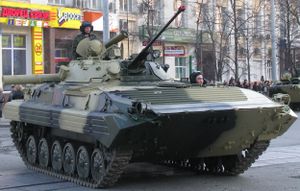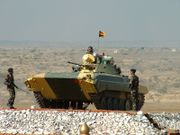BMP-2
| BMP-2 | |
|---|---|
 Russian BMP-2 during a rehearsal for the military parade in Yekaterinburg, 6 May 2009. |
|
| Type | Infantry fighting vehicle |
| Place of origin | |
| Production history | |
| Manufacturer | Kurganmashzavod |
| Specifications | |
| Weight | 14.3 tonnes (15.8 ST; 14.1 LT) |
| Length | 6.72 metres (22 ft 1 in) |
| Width | 3.15 metres (10 ft 4 in) |
| Height | 2.45 metres (8 ft 0 in) |
| Crew | 3 (+7 passengers) |
|
|
|
| Armor | 33 millimetres (1.3 in) (max) [1] |
| Primary armament |
30 mm automatic cannon 2A42 9M113 Konkurs ATGM |
| Secondary armament |
7.62 mm machine gun (PKT) |
| Engine | diesel UTD-20/3 300 hp (225 kW) |
| Power/weight | 21 hp/tonne |
| Suspension | torsion bar |
| Operational range |
600 km (370 mi) |
| Speed | 65 km/h (40 mph) (road) 45 km/h (28 mph) (off-road) 7 km/h (4.3 mph) (water) |
The BMP-2 (Boyevaya Mashina Pekhoty, Russian: Боевая Машина Пехоты; infantry combat vehicle[2]) is a second-generation, amphibious infantry fighting vehicle introduced in the 1980s in the Soviet Union, following the BMP-1 of the 1960s.
Contents |
Development history

Although the BMP-1 was a revolutionary design, its main armament, the 2A28 Grom and the 9S428 ATGM launcher capable of firing the 9M14 Malyutka (NATO: AT-3A Sagger A) and the 9M14M Malyutka-M (NATO: AT-3B Sagger B) ATGMs, quickly became obsolete. Therefore the Soviet Union decided to produce an updated and improved version of the BMP-1. The main emphasis was put on improving the main armament. In 1972 work got underway to develop an improved version of the BMP-1.
During its combat debut in the Yom Kippur War, Egyptian and Syrian BMPs proved vulnerable to .50 calibre machinegun fire in the sides and rear, and to 106 mm recoilless rifles. The 73 mm gun proved inaccurate beyond 500 meters, and the AT-3 Sagger missile could not be guided effectively from the confines of the turret.
Several Soviet technical teams were sent to Syria in the wake of the war to gather information. These lessons combined with observations of western AFV developments resulting in a replacement program for the original BMP in 1974. The first product of this program was the BMP-1P upgrade intended as a stopgap to address the most serious problems with the existing design. Smoke grenade launchers were added to the rear of the turret and the manually guided AT-3 Sagger missile system was replaced with the semi-automatically guided AT-4 Spigot and AT-5 Spandrel system. The new missiles were somewhat difficult to use since the gunner had to actually stand out on the roof to use the weapons, exposing himself to hostile fire. The BMP-1P was in production by the late 1970s and existing BMP-1s were gradually upgraded to the standard during the 1980s.
Description

The BMP-2 is broadly similar to the BMP-1. The most significant changes are:
- A new two-man turret armed with the 2A42 30 mm autocannon and the 9P135M ATGM launcher capable of firing SACLOS guided 9M111 Fagot" (AT-4 Spigot), 9M113 "Konkurs" (AT-5 Spandrel) and 9M113M "Konkurs-M" (AT-5B Spandrel B) anti-tank missiles.
- The commander now sits with the gunner in an enlarged turret.
- Seven troops are carried instead of eight.
- Two rear infantry roof hatches instead of four.
- Slightly improved armour.
The BMP-1 and BMP-2 share the same chassis and have almost identical road performance. The BMP-2 is heavier but also has a more powerful engine to compensate.
The driver sits in the front left of the vehicle, with the engine in a separate compartment to his right. The driver has his own entry hatch above him, with three day periscopes. The centre TNPO-170A periscope can be replaced with either a TNPO-350B extended periscope for amphibious operation or a TVNE-1PA night vision scope. An infantry man sits immediately behind the driver, and has a firing port and vision block. TNPO-170A periscopes are used throughout the vehicle and are electrically heated.
In the centre of the vehicle is the welded steel turret which seats the commander and gunner, both of whom have hatches. The commander sits to the right and has three day vision periscopes, a 1PZ-3 day-sight designed for anti-aircraft use with 1x, 2x and 4x magnification, an OU-3GA2 infra-red searchlight, a TNP-165A designator and a TKN-3B binocular sight with x4.75 day magnification and x4 night-sight magnification.
The gunner sits to the commanders left and has a smaller rectangular hatch with a rearward facing day periscope, additionally there are three other day periscopes facing forward and left. The gunner has a BPK-1-42 binocular sight with a moon/starlight vision range of 650 meters or 350 meters using the infra-red searchlight, and a TNPT-1 designator. A FG-126 infra-red searchlight is mounted coaxially to the 30 mm cannon.
The main armament is a stabilized 30 mm 2A42 autocannon with dual ammunition feeds which provide a choice of 3UBR6 AP-T and 3UOR6 HE-T / 3UOF8 HE-I ammunition. The gun has a selectable rate of fire, either slow at 200 to 300 rounds per minute or fast at 550 rounds per minute. The stabilisation provides reasonable accuracy up to a speed of about 35 kilometres per hour.
The AP-T ammunition can penetrate 15 millimetres of armour at sixty degrees at 1,500 meters, while a new APDS-T tungsten round can penetrate 25 millimetres at the same distance. A typical ammunition load is 160 rounds of AP ammunition and 340 rounds of HE ammunition. The ammunition sits in two trays located on the turret floor rear. The gun can be fired from either the commander or the gunners station.
The commander's 1PZ-3 sight is specifically designed for anti-aircraft operation and combined with the high maximum elevation of 74 degrees, it allows the 30 mm cannon to be used effectively against helicopters and slow flying aircraft. The turret traverse and elevation are powered and it can traverse 360 degrees in 10.28 seconds and elevate through 74 degrees in 12.33 seconds.
Reloading the BMP-2's 30 mm cannon can be somewhat problematic, and can take up to two hours, even if the ammunition is prepared. Additionally the cannon is normally only used on the slow rate of fire, otherwise fumes from the weapon would build up in the turret faster than the extractor fan can remove them.
The effective range of the 30 mm cannon is up to 1500 metres against armor, 2500 metres against ground targets, and 3,000 metres against air targets.
A coaxial 7.62 mm PKT machine gun is mounted to the left of the 30 mm cannon, and 2,000 rounds of ammunition are carried for it. On the roof of the turret is an ATGM launcher, on Russian vehicles this fires AT-5 Spandrel missiles, but on export models it normally fires AT-4 Spigot missiles. A ground mount for the missile is also carried, allowing it to be used away from the vehicle. The missiles are a substantial improvement on the AT-3 Sagger missiles used on the BMP-1, in both range and accuracy.
Behind the turret is the troop compartment which holds six troops, the seventh sits just behind the driver. The troops sit back to back, along the centre of the vehicle. Down each side of the compartment are three firing ports with periscopes. Access to the compartment is by the two rear doors, which also hold fuel tanks, both doors have integral periscopes and the left door has a firing port.
In addition to the main weapons it can carry a man portable surface to air missile launcher and two missiles, and an RPG launcher and five rounds. The vehicle is fitted with a PAZ overpressure NBC system and fire suppression system, and carries a GPK-59 gyrocompass.
The BMP-2's armour is broadly similar to the original BMP-1. Its frontal and side armour is no longer effective against the most recent .50-calibre SLAP [Sabotted light anti-armour projectile] and the 25 mm cannon of the US M2 Bradley MICV or the British GKN Warrior IFV 30 RARDEN. Like the BMP-1, the rear doors of the BMP-2 are filled with diesel fuel offering some risk from incendiary rounds. These additional fuel tanks are shut off from the fuel system when in combat.
The BMP-2 is amphibious with little preparation, using hydrodynamic fairings to convert track momentum into water jets. Peacetime regulations require that any BMPs entering water must have a working radio set, since its bearings are not airtight and it can be carried away by currents in case of loss of engine power (the vehicle lacks an anchor).
Protection issues
The original BMP-1 had a significant shortcoming in its protection scheme, which only became obvious during the 1979 invasion of Afghanistan. The one-man-turret fighting vehicle seated its driver and commander in tandem layout, in the front-left side of the hull alongside the diesel engine. When a BMP-1 hit the obsolete kind of "tilt-rod" antitank landmine, its steeply sloped lower front glacis armour plate allowed the mine's arming rod to tilt with little resistance until the maximum deflection was reached with the mine already well under the chassis. When it subsequently detonated, the blast usually killed both the driver and the vehicle commander, causing a significant loss of specialist personnel in the Soviet Red Army.
This shortcoming was addressed in the BMP-2 design, where the tank commander shares the well-armoured two-man turret with the gunner. The driver's station has been enlarged and he is provided with an armoured driver's seat, in addition to extra belly-armour in the lower front.
The problem most often cited by western analysts is the design of the main fuel tanks. Due to the low profile of the vehicle the designers had to place the fuel tanks between the two rows of outward-facing passenger seats, in other words, the infantry passengers actually sit on the bulk of the vehicle fuel storage, with extra fuel carried in the hollow rear doors. As the rear doors are weakly armoured, a hit with any kind of incendiary round will send burning fuel into the crew compartment, resulting in horrendous injuries and painful death to the occupants trapped inside the burning vehicle and a possible explosion.
However the rear door tanks are not always filled as they are meant to increase road travel range of the vehicle, and are almost always empty when the BMP goes into combat. In intense war areas where the BMP sees action relatively often and relatively near to its base of operation, it is a practice not to fill them at all as a rule, and to add fuel to the internal tanks from other sources if the need arises. That however also means that an attack conducted behind enemy lines in a relatively safe area would have much more effect. Nonetheless, the inner fuel tanks (which are used) are more vulnerable than those of many modern IFVs - the weak armor means powerful shots (like RPGs in Chechnya and Afghanistan) can pierce both the outside vehicle armor and the inner tank armor. The last argument however comes from the fact that BMP is a lighter vehicle than some other designs. Naturally, heavier and more powerful vehicles, such as BTR-T, offer a substantially better protection.
Furthermore, it is not clear what could be a better alternative to the infantry positioning in a IFV. A hit, which actually reaches the center of a vehicle [and the fuel tanks] would presumably impact the infantry inside first. Also, investigation by USAF LTC James Burton demonstrated that the center of a vehicle is more likely to be hit, which implies that placing the whole complement of infantry in the center of a vehicle is potentially even more dangerous.
Therefore, the arguments about the design of the fuel tanks or crew positioning in the BMP can only be considered an opinion, as there is no clearly better alternative given weight, functionality, and mobility requirements.
The basic hull armour on the BMP-2 can be easily penetrated by any shaped-charge missile, from the 66 mm LAW on up. Due to this limitation, Russian troops in combat zones customarily ride outside the BMP, sitting on top. This limits the chance that a single RPG round could kill or wound everyone inside the vehicle, but has obvious downside on the likelihood of passenger survivability in a war-zone. One important modification carried out as the result of operational experience in Afghanistan was the fitting of a second layer of stand-off armour, usually a high resistant ballistic rubber-like material, to act as spaced armour around the top of the hull sides and around the turret.
Service history
In the Soviet Army, BMPs were typically issued to the motor rifle battalions of tank regiments. In a typical motor-rifle division, one motor-rifle regiment had BMPs, the other two had wheeled BTRs.
Proliferation varied greatly among the rest of the Warsaw Pact nations. For example, at least some East German motor-rifle divisions were recorded to have all three motor-rifle regiments with BMPs, ranging down to the Romanian and Bulgarian Armies, some of whose divisions had no BMPs at all.[3]
Poland planned to replace it's BWP-1s with BWP-2s (BMP-2s and BMP-2Ds) but because of financial problems was able to order only 62 vehicles in 1988 which were delivered in 1989. Since obtaining sufficient number of BWP-2s after political changes of 1989 became impossible Poland was forced to abandon this plan. 62 BWP-2s that Poland bought were sold in 1995 to Angola.[4][5][6]
Combat history


- 1975 - 2002 Angolan Civil War
- 1979 - 1989 Soviet war in Afghanistan
- 1980 - 1988 Iran-Iraq war
- 1988 - 1993 Georgian Civil War
- 1991 - 1992 War in South Ossetia
- 1992 - 1993 War in Abkhazia
- 1988 - 1994 Nagorno-Karabakh War
- 1989 - Georgian-Ossetian conflict
- 2008 - War in South Ossetia
- 1990 - 1991 First Persian Gulf War
- 1992 - 1997 Civil War in Tajikistan
- 1994 Civil War in Yemen
- 1994 - 1996 First Chechen War
- 1998 Six-Day War of Abkhazia
- 1999 - Second Chechen War
- 2001 - War in Afghanistan (2001–present)
- 2003 - Second Persian Gulf War
- 2008 - South Ossetia War
Variants

former Soviet Union

- BMP-2 obr. 1980 - Initial production model.
- BMP-2 obr. 1984 - Improved version with "kovriki" armour on turret front.
- BMP-2 obr. 1986 - Late-production model with new sight BPK-2-42 instead of the BPK-1-42.
- BMP-2D (D stands for "desantnaya" - assault) - Fitted with additional spaced type steel appliqué armour on the hull sides, under the driver's and commander's stations, and 6 mm thick appliqué armour on the turret. Due to the added weight the vehicle is no longer amphibious. It also has provision for mounting mine clearing system under the nose of the vehicle. In service since 1982, it saw service during Soviet war in Afghanistan. During that conflict western observers saw the vehicle for the first time and gave it a designation BMP-2E.[6][7]
- BMP-2K (K stands for "komandnyj" - command) - Command variant fitted with two whip antennas mounted on the rear of the hull, one behind the turret and one on the right-hand side of the rear of the vehicle, one IFF antenna (pin stick) on the left-hand side of the rear of the vehicle and a support for a telescopic mast in the front of the IFF antenna. The firing port equipped with the periscope was removed from either side of the vehicle. The antennae on the turret has been removed. The radio equipment consists of the R-123M and R-130M radio sets, or more modern R-173, R-126 and R-10. The crew consists of six soldiers.[6]
- BMP-2M - General designator for upgraded versions. The version BMP-2M "Berezhok"[8] from KBP has an additional AG-30 grenade launcher, 2+2 launchers for ATGM "Kornet" and new day/night sights as found on the BMD-4. This upgrade was selected by Algeria. The Russian armed forces ordered the upgrade package from KMZ with UTD-23 engine of 360hp, new sights BPK-3-42 and TKN-AI, additional passive armour and an air conditioning unit.
- BMO-1 (boyevaya mashina ognemyotchikov) - Transport vehicle for a flamethrower squad, armed with 30x93 mm RPO "Shmel" napalm rocket launchers. It is equipped with storage racks and a dummy turret. The crew consists of seven soldiers. It entered service in 2001.[6]
- BMP-2 obr. 1984 - Improved version with "kovriki" armour on turret front.
former Czechoslovakia
- BVP-2 (bojové vozidlo pěchoty) - Czechoslovak produced version of BMP-2.
- BVP-2V or VR 1p (vozidlo velitele roty) - Command vehicle with tent, telescopic mast and radiosets RF 1325 (x 2), IPRS 32, RF 1301 and NS 2480D. [9] Photos
- VPV (VPV stands for Vyprošťovací Pásové Vozidlo) - BVP-2 convention into an ARV developed at the ZTS Martin Research and Development Institute and production commenced at the ZTS Martin plant (which is now in Slovakia) in 1984. It is equipped with a powered crane with 5 tonnes capacity, heavy winch, wider troop compartment etc. Hatches on top of the turret and the troop compartment were removed. The vehicle is divided into four compartments: engine, commander's, driver's and repair/cargo. The crew consists of a Commander/crane operator, Driver/welder/slinger and a logistician/mechanic. The vehicle is armed with a pintle mounted 7.62 mm PKT light machine gun. A small number of those vehicles was also based on BVP-1.Photos[6]
India

- BMP-2 "Sarath" ("Chariot of Victory") - Indian license-produced variant of BMP-2[6], built by the Ordnance Factory Medak. The first vehicle, assembled from components supplied by KBP, was ready in 1987. By 1999, about 90% of the complete vehicle and its associated systems was being produced in India. It was estimated in 2002 that 1,200 vehicles were built.
- BMP-2 "Sarath" based armoured ambulance. It retains the turret but without the gun or smoke grenade launchers.[6] The troop compartment has been modified to carry four stretchers.
- BMP-2 "Sarath" based armoured recovery vehicle. It is fitted with a light hydraulic crane.[6]
- BMP-2 "Sarath" based armoured amphibious dozer. Turret-less combat engineer vehicle, fitted with a folding dozer blade at the rear, mine ploughs, a main winch with a capacity of 8,000 kg and a rocket-propelled earth anchor for self-recovery.
- BMP-2 "Sarath" based armoured engineer reconnaissance vehicle. This version has no gun and is fitted with lots of specialised equipment, including an echo-sounder, a water current meter, a laser range finder and GPS. On the left rear of the hull, a marking system with 40 rods is fitted.
- BMP-2 "Sarath" based NBC reconnaissance vehicle. Externally very similar to the basic vehicle but fitted with all kinds of sampling, testing and marking systems. The NBCRV was developed by DRDO and VRDE and has been ordered by the Indian army.
- BMP-2 "Sarath" based carrier mortar tracked vehicle. This turret-less version has a 81 mm mortar[10] mounted in the modified troop compartment. The mortar is fired through an opening in the hull roof that has two hinged doors. It has a max. range of 5,000 m and a normal rate of fire of 6-8 rds/min. There is also a longe-range version of the mortar.[11] The vehicle carries 108 mortar rounds and is also fitted with a 7.62 mm machine gun with 2,350 rounds. Crew: 2+4.[12] The first prototype was complete in 1997.
- Namica (Nag Missile Carrier) - Tank destroyer without turret and with a higher roofline. The "Nag" (cobra) missile is launched from a retractable armoured launcher that contains four launch tubes and the guidance package. "Nag" is a fire-and-forget top-attack ATGM with a tandem-HEAT warhead and a range of at least 4,000 m.
- Akash - Air-defence missile system that is based on a modified "Sarath" chassis with 7 road wheels. On top of the hull there's a launcher for three SAM's with a range of 27 km and semi-active homing guidance.[6]
- Rajendra - This is a multifunctional 3-D phased radar (MUFAR), associated with the Akash system. It is also based on the stretched chassis.
- BMP-2 "UGV" - unmanned reconnaissance vehicle fitted with equipment used to detect nuclear, biological and chemical contamination as well as mines.
Israel
- BMP-2 upgrade designed by Nimda fitting it with new power unit and automatic transmission which improves both mobility and reliability.[13]
Poland
- BWP-2 - Polish designation for BMP-2 and BMP-2D.[6]
Operators
 Abkhazia - 80 BMP-1s and BMP-2s were claimed by the Abkhaziyan Army.[14]
Abkhazia - 80 BMP-1s and BMP-2s were claimed by the Abkhaziyan Army.[14] Afghanistan - [4] 150 along with 1,500 9M111 Fagot ATGMs were ordered in 1987 from the Soviet Union and delivered between 1987 and 1991 (some of the vehicles were possibly previously in Soviet service).[5] 550 BMP-1s and BMP-2s in service in 1992.[15] Between 60 and 80 BMP-1s and BMP-2s were delivered from Russia after 2002.[16]
Afghanistan - [4] 150 along with 1,500 9M111 Fagot ATGMs were ordered in 1987 from the Soviet Union and delivered between 1987 and 1991 (some of the vehicles were possibly previously in Soviet service).[5] 550 BMP-1s and BMP-2s in service in 1992.[15] Between 60 and 80 BMP-1s and BMP-2s were delivered from Russia after 2002.[16] Albania - More than 13 BMP-2s acquired from East German stock in 1995.
Albania - More than 13 BMP-2s acquired from East German stock in 1995. Algeria - 225 along with 2,250 9M111 Fagot ATGMs were ordered in 1989 from the Soviet Union and delivered between 1990 and 1991. 54 BVP-2s and BVP-2Ks were ordered in 1994 from Slovakia and delivered between 1995 and 1996. 64 were ordered in 1998 from Ukraine and delivered between 1998 and 1999 (the vehicles were previously in Soviet and later Ukrainian service). In 2005 Algeria ordered modernization of 300 of its BMP-2s to the BMP-2M standard which started in 2006 and is scheduled to be completed in 2010. 160 were modernized between 2006 and 2008.[5]
Algeria - 225 along with 2,250 9M111 Fagot ATGMs were ordered in 1989 from the Soviet Union and delivered between 1990 and 1991. 54 BVP-2s and BVP-2Ks were ordered in 1994 from Slovakia and delivered between 1995 and 1996. 64 were ordered in 1998 from Ukraine and delivered between 1998 and 1999 (the vehicles were previously in Soviet and later Ukrainian service). In 2005 Algeria ordered modernization of 300 of its BMP-2s to the BMP-2M standard which started in 2006 and is scheduled to be completed in 2010. 160 were modernized between 2006 and 2008.[5] Angola - 65 along with 650 9M111 Fagot ATGMs were ordered in 1987 from the Soviet Union and delivered in 1987. 7 were ordered in 1993 from Hungary and delivered in 1993 (the vehicles were previously in Hungarian service and were sold via Czech Republic). 62 BMP-2s and BMP-2Ds[6] were ordered in 1994 from Poland and delivered between 1994 and 1995 (the vehicles were previously in Polish service). 65 were ordered in 1997 from Russia and delivered in 1998 (the vehicles were possibly previously in Soviet and later Russian service). 62 were ordered in 1999 from Belarus and delivered in 1999 (the vehicles were previously in Soviet and later Belorussian service). 31 were ordered in 1999 from Ukraine and delivered in 1999 (the vehicles were previously in Soviet and later Ukrainian service).[5] 62 are currently in service.[17]
Angola - 65 along with 650 9M111 Fagot ATGMs were ordered in 1987 from the Soviet Union and delivered in 1987. 7 were ordered in 1993 from Hungary and delivered in 1993 (the vehicles were previously in Hungarian service and were sold via Czech Republic). 62 BMP-2s and BMP-2Ds[6] were ordered in 1994 from Poland and delivered between 1994 and 1995 (the vehicles were previously in Polish service). 65 were ordered in 1997 from Russia and delivered in 1998 (the vehicles were possibly previously in Soviet and later Russian service). 62 were ordered in 1999 from Belarus and delivered in 1999 (the vehicles were previously in Soviet and later Belorussian service). 31 were ordered in 1999 from Ukraine and delivered in 1999 (the vehicles were previously in Soviet and later Ukrainian service).[5] 62 are currently in service.[17] Armenia
Armenia
 Four Azerbaijani BMP-2s on a military parade in Baku, Azerbaijan, June 2008.
Four Azerbaijani BMP-2s on a military parade in Baku, Azerbaijan, June 2008. Czech BVP-2 on a Military parade in Prague, 28 October 2008.Two Finnish BMP-2s, 25 October 2004.
Czech BVP-2 on a Military parade in Prague, 28 October 2008.Two Finnish BMP-2s, 25 October 2004. Azerbaijan - 53 BMP-2s in service with the armed forces in 1992, 88 in 1993, 191 in 1994, 206 in 1995, 197 in 1996, 96 in 1997 and 1998, 91 in 1999, 41 in 2000–2004, and 39 in 2006. 100 BMP-2s in service with the border troops in 1997–1999, and 147 in 2000–2006[18]
Azerbaijan - 53 BMP-2s in service with the armed forces in 1992, 88 in 1993, 191 in 1994, 206 in 1995, 197 in 1996, 96 in 1997 and 1998, 91 in 1999, 41 in 2000–2004, and 39 in 2006. 100 BMP-2s in service with the border troops in 1997–1999, and 147 in 2000–2006[18] Belarus - 1,278 were in service in 1995 and 1,164 in 2000, 2003 and 2005.[19]
Belarus - 1,278 were in service in 1995 and 1,164 in 2000, 2003 and 2005.[19] Côte d'Ivoire - 2 ordered in 2002 from Angola and delivered in 2002 (the vehicles were previously in Angolan service). 1 ordered in 2003 from Ukraine and delivered in 2003 (the vehicle probably was previously in Ukrainian service).[5]
Côte d'Ivoire - 2 ordered in 2002 from Angola and delivered in 2002 (the vehicles were previously in Angolan service). 1 ordered in 2003 from Ukraine and delivered in 2003 (the vehicle probably was previously in Ukrainian service).[5] Czech Republic - 200 inherited from former Czechoslovakia.[4] 174 in service in 1 January 2008.[20]
Czech Republic - 200 inherited from former Czechoslovakia.[4] 174 in service in 1 January 2008.[20] Finland - 20 were ordered in 1988 from the Soviet Union and delivered between 1988 and 1989. 84 along with 420 9M111 Fagot and 420 9M113 Konkurs ATGMs were ordered in 1991 from the Soviet Union and delivered in 1992 by Russia.[5] At peak there were 110 BMP-2s.[21] 100 are currently in service.[4]
Finland - 20 were ordered in 1988 from the Soviet Union and delivered between 1988 and 1989. 84 along with 420 9M111 Fagot and 420 9M113 Konkurs ATGMs were ordered in 1991 from the Soviet Union and delivered in 1992 by Russia.[5] At peak there were 110 BMP-2s.[21] 100 are currently in service.[4] Georgia - 40 were ordered in 2004 from Ukraine and were delivered between 2004 and 2005 (the vehicles were previously in Soviet and later Ukrainian service).[5] 11 in service in 2000, 13 in 2002 and 2005 and 57 in 2008.[22] Currently 120 are in service.[23]
Georgia - 40 were ordered in 2004 from Ukraine and were delivered between 2004 and 2005 (the vehicles were previously in Soviet and later Ukrainian service).[5] 11 in service in 2000, 13 in 2002 and 2005 and 57 in 2008.[22] Currently 120 are in service.[23] India - [4] 700 BMP-2 "Sarath" ordered in 1984 from the Soviet Union and delivered between 1987 and 1991 (most produced in India). 400 BMP-2 "Sarath" ordered in 1985 and produced in India between 1992 and 1995 under Russian license. 123 BMP-2K ordered in 2006 from Russia and delivered between 2007 and 2008.[5] Around 300 BMP-2 "Sarath" were in service in 1995, 1,000 in 2000 and 2002, around 1,000 in 2005 and more than 1,000 in 2008.[24] Currently more than 900 are in active service.[25]
India - [4] 700 BMP-2 "Sarath" ordered in 1984 from the Soviet Union and delivered between 1987 and 1991 (most produced in India). 400 BMP-2 "Sarath" ordered in 1985 and produced in India between 1992 and 1995 under Russian license. 123 BMP-2K ordered in 2006 from Russia and delivered between 2007 and 2008.[5] Around 300 BMP-2 "Sarath" were in service in 1995, 1,000 in 2000 and 2002, around 1,000 in 2005 and more than 1,000 in 2008.[24] Currently more than 900 are in active service.[25] Iran - 1,500 ordered in 1991 from Russia and 413 were delivered between 1993 and 2001 of which 82 were delivered directly by Russia and 331 were assembled in Iran.[5] 100 were in service in 1995, 140 in 2000 and 400 in 2002, 2005 and 2008.[26] 400 are currently in service.[27]
Iran - 1,500 ordered in 1991 from Russia and 413 were delivered between 1993 and 2001 of which 82 were delivered directly by Russia and 331 were assembled in Iran.[5] 100 were in service in 1995, 140 in 2000 and 400 in 2002, 2005 and 2008.[26] 400 are currently in service.[27] Indonesia - 9 ordered in 1998 from Ukraine and delivered in 1998 (the vehicles were possibly previously in Soviet and later Ukrainian service and were sold via Slovakia). 2 ordered in 1998 from Ukraine and delivered in 1998 (the vehicles were possibly previously in Soviet and later Ukrainian service and were sold via Slovakia). 11 BVP-2s ordered in 1999 from Slovakia and delivered in 2000 (the vehicles were probably previously in Czechoslovak and later Slovakian service).[5] 40 ex-Czech BVP-2s are currently in service.
Indonesia - 9 ordered in 1998 from Ukraine and delivered in 1998 (the vehicles were possibly previously in Soviet and later Ukrainian service and were sold via Slovakia). 2 ordered in 1998 from Ukraine and delivered in 1998 (the vehicles were possibly previously in Soviet and later Ukrainian service and were sold via Slovakia). 11 BVP-2s ordered in 1999 from Slovakia and delivered in 2000 (the vehicles were probably previously in Czechoslovak and later Slovakian service).[5] 40 ex-Czech BVP-2s are currently in service. Jordan - 35[28]
Jordan - 35[28] Kazakhstan - 100 were in service in 1995, 140 in 2000 and 400 in 2002 and 2005.[29] Currently 300 are in service.
Kazakhstan - 100 were in service in 1995, 140 in 2000 and 400 in 2002 and 2005.[29] Currently 300 are in service. Kuwait - [4] 245 along with 2,450 9M111 Fagot ATGMs were ordered in 1988 from the Soviet Union and delivered between 1989 and 1990. Some captured or destroyed by the Iraqi forces. 46 along with 460 9M111 Fagot ATGMs were ordered in 1994 from Russia and delivered between 1994 and 1995.[5] 46 were in service in 1995 and 2000 and 76 in 2005.[30]
Kuwait - [4] 245 along with 2,450 9M111 Fagot ATGMs were ordered in 1988 from the Soviet Union and delivered between 1989 and 1990. Some captured or destroyed by the Iraqi forces. 46 along with 460 9M111 Fagot ATGMs were ordered in 1994 from Russia and delivered between 1994 and 1995.[5] 46 were in service in 1995 and 2000 and 76 in 2005.[30] Kyrgyzstan - 101
Kyrgyzstan - 101 Macedonia - 11 were ordered in 2001 from Ukraine and delivered in 2001 (the vehicles were previously in Soviet and later Ukrainian service).[5][31] 10 are currently in service.
Macedonia - 11 were ordered in 2001 from Ukraine and delivered in 2001 (the vehicles were previously in Soviet and later Ukrainian service).[5][31] 10 are currently in service. Russia - [4] 12,200 BMP-1s, BMP-2s and BMP-3s in 1995 and 12,700 in 2000–2009.[32] 2,750 are currently in active service and 6,500 are in reserve.[33]
Russia - [4] 12,200 BMP-1s, BMP-2s and BMP-3s in 1995 and 12,700 in 2000–2009.[32] 2,750 are currently in active service and 6,500 are in reserve.[33] Sierra Leone - 4 were ordered in 1992 from Russia and delivered in 1992 (the vehicles were second-hand).[5] 12 are currently in service.
Sierra Leone - 4 were ordered in 1992 from Russia and delivered in 1992 (the vehicles were second-hand).[5] 12 are currently in service. Slovakia - [4] 93[34]
Slovakia - [4] 93[34] Sri Lanka - 4 were ordered in 1994 from Ukraine and delivered in 1994 (the vehicles were previously in Soviet and later Ukrainian service). 36 were ordered in 2001 from Russia and delivered in 2001.[5]
Sri Lanka - 4 were ordered in 1994 from Ukraine and delivered in 1994 (the vehicles were previously in Soviet and later Ukrainian service). 36 were ordered in 2001 from Russia and delivered in 2001.[5] Sudan - 6 were ordered in 1995 from Ukraine and delivered in 1996 (the vehicles were probably previously in Soviet and later Ukrainian service). 9 were ordered in 2003 from Belarus and delivered in 2003 (the vehicles were previously in Soviet and later Belorussian service).[5]
Sudan - 6 were ordered in 1995 from Ukraine and delivered in 1996 (the vehicles were probably previously in Soviet and later Ukrainian service). 9 were ordered in 2003 from Belarus and delivered in 2003 (the vehicles were previously in Soviet and later Belorussian service).[5] Syria - 100 were ordered in 1987 from the Soviet Union and were delivered between 1987 and 1988.[5]
Syria - 100 were ordered in 1987 from the Soviet Union and were delivered between 1987 and 1988.[5] Tajikistan - 25 were in service in 2000 and 2005.[35]
Tajikistan - 25 were in service in 2000 and 2005.[35] Togo - 20 ordered in 1996 from an unknown supplier (officially Poland despite the fact that all 62 Polish BWP-2s were exported to Angola) and delivered in 1997.[5]
Togo - 20 ordered in 1996 from an unknown supplier (officially Poland despite the fact that all 62 Polish BWP-2s were exported to Angola) and delivered in 1997.[5] Turkmenistan - 538 BMP-1s and BMP-2s were in service in 1995, 930 in 2000 and 2005.[36]
Turkmenistan - 538 BMP-1s and BMP-2s were in service in 1995, 930 in 2000 and 2005.[36] Uganda - 31 were ordered in 2003 from Ukraine and were delivered between 2004 and 2005 (the vehicles were previously in Soviet and later Ukrainian service).[5]
Uganda - 31 were ordered in 2003 from Ukraine and were delivered between 2004 and 2005 (the vehicles were previously in Soviet and later Ukrainian service).[5]

 Ukraine - 1,460 were in service in 1995, 1,467 in 2000 and 1,434 in 2005.[37] Currently 1,400 are in service.[38]
Ukraine - 1,460 were in service in 1995, 1,467 in 2000 and 1,434 in 2005.[37] Currently 1,400 are in service.[38] Uzbekistan - 97 were in service in 1995, 160 in service in 2000 and 270 in service in 2005.[39]
Uzbekistan - 97 were in service in 1995, 160 in service in 2000 and 270 in service in 2005.[39] Vietnam - 150 along with 1,500 9M111 Fagot ATGMs were ordered in 1982 from the Soviet Union and were delivered between 1982 and 1984.[5] Currently 600 are in service.
Vietnam - 150 along with 1,500 9M111 Fagot ATGMs were ordered in 1982 from the Soviet Union and were delivered between 1982 and 1984.[5] Currently 600 are in service. Yemen - 100 were ordered in 2002 from Ukraine and were delivered between 2003 and 2004 (the vehicles were probably previously in Soviet and later Ukrainian service). Between 180 and 188 BMP-2Ds were ordered in 2004 from Russia and were delivered between 2004 and 2005.[5] Currently 334 are in service.
Yemen - 100 were ordered in 2002 from Ukraine and were delivered between 2003 and 2004 (the vehicles were probably previously in Soviet and later Ukrainian service). Between 180 and 188 BMP-2Ds were ordered in 2004 from Russia and were delivered between 2004 and 2005.[5] Currently 334 are in service.
Former operators

 Czechoslovakia - 279 ordered in 1978 and produced between 1983 and 1989.[5] Passed on to the successor states.
Czechoslovakia - 279 ordered in 1978 and produced between 1983 and 1989.[5] Passed on to the successor states. East Germany - 24 were ordered in 1985 from the Soviet Union and were delivered between 1986 and 1987 (the vehicles were possibly produced in Czechoslovakia).[5] Passed on to the unified German state.
East Germany - 24 were ordered in 1985 from the Soviet Union and were delivered between 1986 and 1987 (the vehicles were possibly produced in Czechoslovakia).[5] Passed on to the unified German state. West Germany/
West Germany/ Germany - 24, taken from East Germany's army, all sold to other countries or given to the museums.
Germany - 24, taken from East Germany's army, all sold to other countries or given to the museums. Iraq - [4] 200 were ordered in 1986 from the Soviet Union and were delivered between 1987 and 1989 (some of the vehicles were possibly produced in Czechoslovakia).[5] 1,500 BMP-1s and BMP-2s in service in 1990, about 900 in 1995, about 1000 in 2000 and about 900 in 2002.[40] Possibly captured some from Kuwait in the First Persian Gulf War. All destroyed or scrapped.
Iraq - [4] 200 were ordered in 1986 from the Soviet Union and were delivered between 1987 and 1989 (some of the vehicles were possibly produced in Czechoslovakia).[5] 1,500 BMP-1s and BMP-2s in service in 1990, about 900 in 1995, about 1000 in 2000 and about 900 in 2002.[40] Possibly captured some from Kuwait in the First Persian Gulf War. All destroyed or scrapped. Poland - 62 BMP-2s and BMP-2Ds (all of which were designed as BWP-2s) ordered in 1988 and delivered in 1989. Sold in 1994 to Angola and delivered between 1994 and 1995.[4][5]
Poland - 62 BMP-2s and BMP-2Ds (all of which were designed as BWP-2s) ordered in 1988 and delivered in 1989. Sold in 1994 to Angola and delivered between 1994 and 1995.[4][5] Soviet Union - 24,000 BMP-1s and BMP-2s in service in 1985.[32] Passed on to successor states.
Soviet Union - 24,000 BMP-1s and BMP-2s in service in 1985.[32] Passed on to successor states.
See also
- BMP Development
- BMD-1 - related family of Soviet airborne fighting vehicles
- BMP-1
- BMP-3
- Combat Vehicle 90
- M2 Bradley
- Warrior Tracked Armoured Vehicle
Notes
- ↑ fas.org info about BMP-2
- ↑ Soderzhaniye
- ↑ Pact
- ↑ 4.0 4.1 4.2 4.3 4.4 4.5 4.6 4.7 4.8 4.9 BMP-2 Pancerni.net 1
- ↑ 5.00 5.01 5.02 5.03 5.04 5.05 5.06 5.07 5.08 5.09 5.10 5.11 5.12 5.13 5.14 5.15 5.16 5.17 5.18 5.19 5.20 5.21 5.22 5.23 SIPRI Arms Transfers Database
- ↑ 6.00 6.01 6.02 6.03 6.04 6.05 6.06 6.07 6.08 6.09 6.10 JED The Military Equipment Directory
- ↑ "Gary's Combat Vehicle Reference Guide"
- ↑ Армс-Тасс
- ↑ CZE - BVP-2V (velitelské stanoviště) :: forum.valka.cz
- ↑ Ordnance Factory Board
- ↑ Ordnance Factory Board
- ↑ Ordnance Factory Board
- ↑ Nimda Group Ltd. - commercial and military systems in energy, transportation and automotive applications
- ↑ [1]
- ↑ История России. Всемирная, мировая история - Афганистан в конце XX в
- ↑ Defence Express News - РОССИЯ И АФГАНИСТАН ВЫПОЛНЯЮТ ДОГОВОРЕННОСТИ, ЗАКЛЮЧЕННЫЕ МЕЖДУ ВОЕННЫМИ ВЕДОМСТВАМИ ДВУХ СТРАН В КАБУЛЕ В 2002 Г
- ↑ Angolan army armyrecognition.com
- ↑ МЕЖДУНАРОДНЫЙ КОНТРОЛЬ НАД ОБЫЧНЫМИ ВООРУЖЕНИЯМИ И НЕКОНТРОЛИРУЕМОЕ ОРУЖИЕ
- ↑ Belarus Army Equipment
- ↑ "Czech Ministry of Defense"
- ↑ Fin Army equipment
- ↑ Georgia Army
- ↑ Georgian army armyrecognition.com
- ↑ Indian Army Equipment
- ↑ Bharat Rakshak :: Land Forces Site - BMP-2
- ↑ Iranian Ground Forces Equipment
- ↑ Iranian army armyrecognition.com
- ↑ Jordanian Army equipment
- ↑ Kazak Ground Forces Equipment
- ↑ Kuwait - Army Equipment
- ↑ Macedonian Armor
- ↑ 32.0 32.1 Russian Army Equipment
- ↑ warfare.ru
- ↑ Slovakian Army equipment
- ↑ Tajik-Army Equipment
- ↑ Turkmen-Army Equipment
- ↑ Ground Forces Equipment - Ukraine
- ↑ Ukrainian army armyrecognition.com
- ↑ Uzbek-Army Equipment
- ↑ Iraqi Ground Forces Equipment
References
- Jane's Armour and Artillery 2005-2006.
- Andrew W. Hull, David R. Markov, Steven J. Zaloga. Soviet/Russian Armor and Artillery Design Practices:1945 to Present.
- Tsouras, P.G. Changing Orders: The evolution of the World's Armies, 1945 to the Present Facts On File, Inc, 1994. ISBN 0-8160-3122-3
- FM 100-60
- Ustyantsev, Sergej Viktorovich; Kolmakov Dmitrij Gennadevich Boyeviye mashiny Uralvagonzavoda. Tank T-72
- A.V. Karpenko (1996) Obozreniye Bronetankovoj Tekhniki (1905-1995 gg.) Nevskij Bastion
- Perrett, Bryan (1987). Soviet Armour Since 1945. London: Blandford Press. ISBN 0-7137-1735-1.
Further reading
- Grau, Lester W. Russian-Manufactured Armored Vehicle Vulnerability in Urban Combat: The Chechnya Experience, Red Thrust Star, January 1997
External links
- SOVIET BMP-2 Infantry Fighting Vehicle – Walk around photos
- Global Security Article on the BMP-2
- BMP-2 at indian-military.org
|
||||||||||||||||||||||||||||||||||||||||||||||||||||||||||||